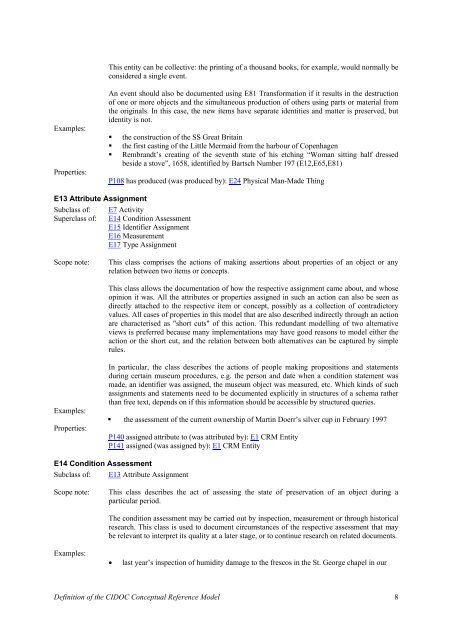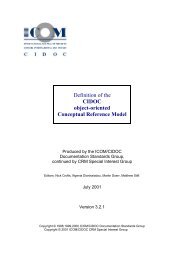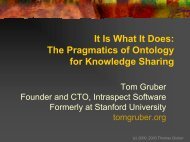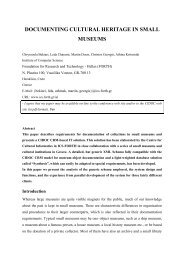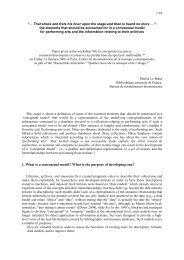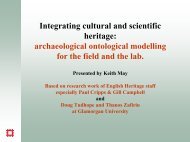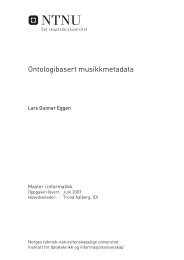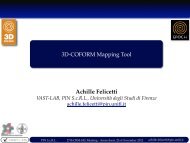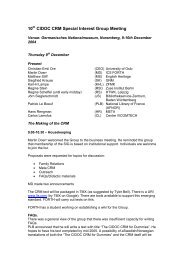pdf file - The CIDOC CRM
pdf file - The CIDOC CRM
pdf file - The CIDOC CRM
Create successful ePaper yourself
Turn your PDF publications into a flip-book with our unique Google optimized e-Paper software.
This entity can be collective: the printing of a thousand books, for example, would normally be<br />
considered a single event.<br />
Examples:<br />
Properties:<br />
An event should also be documented using E81 Transformation if it results in the destruction<br />
of one or more objects and the simultaneous production of others using parts or material from<br />
the originals. In this case, the new items have separate identities and matter is preserved, but<br />
identity is not.<br />
• the construction of the SS Great Britain<br />
• the first casting of the Little Mermaid from the harbour of Copenhagen<br />
• Rembrandt’s creating of the seventh state of his etching “Woman sitting half dressed<br />
beside a stove”, 1658, identified by Bartsch Number 197 (E12,E65,E81)<br />
P108 has produced (was produced by): E24 Physical Man-Made Thing<br />
E13 Attribute Assignment<br />
Subclass of: E7 Activity<br />
Superclass of: E14 Condition Assessment<br />
E15 Identifier Assignment<br />
E16 Measurement<br />
E17 Type Assignment<br />
Scope note:<br />
This class comprises the actions of making assertions about properties of an object or any<br />
relation between two items or concepts.<br />
This class allows the documentation of how the respective assignment came about, and whose<br />
opinion it was. All the attributes or properties assigned in such an action can also be seen as<br />
directly attached to the respective item or concept, possibly as a collection of contradictory<br />
values. All cases of properties in this model that are also described indirectly through an action<br />
are characterised as "short cuts" of this action. This redundant modelling of two alternative<br />
views is preferred because many implementations may have good reasons to model either the<br />
action or the short cut, and the relation between both alternatives can be captured by simple<br />
rules.<br />
Examples:<br />
Properties:<br />
In particular, the class describes the actions of people making propositions and statements<br />
during certain museum procedures, e.g. the person and date when a condition statement was<br />
made, an identifier was assigned, the museum object was measured, etc. Which kinds of such<br />
assignments and statements need to be documented explicitly in structures of a schema rather<br />
than free text, depends on if this information should be accessible by structured queries.<br />
• the assessment of the current ownership of Martin Doerr’s silver cup in February 1997<br />
P140 assigned attribute to (was attributed by): E1 <strong>CRM</strong> Entity<br />
P141 assigned (was assigned by): E1 <strong>CRM</strong> Entity<br />
E14 Condition Assessment<br />
Subclass of: E13 Attribute Assignment<br />
Scope note:<br />
This class describes the act of assessing the state of preservation of an object during a<br />
particular period.<br />
<strong>The</strong> condition assessment may be carried out by inspection, measurement or through historical<br />
research. This class is used to document circumstances of the respective assessment that may<br />
be relevant to interpret its quality at a later stage, or to continue research on related documents.<br />
Examples:<br />
• last year’s inspection of humidity damage to the frescos in the St. George chapel in our<br />
Definition of the <strong>CIDOC</strong> Conceptual Reference Model 8


